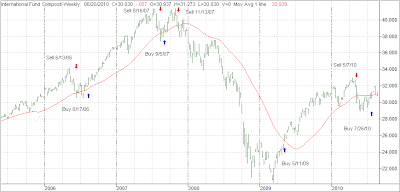 With the bursting of the credit bubble, and the so far unsuccessful attempts by the Fed to reignite inflation, a deflationary scenario a la Japan seems to be a real possibility.
With the bursting of the credit bubble, and the so far unsuccessful attempts by the Fed to reignite inflation, a deflationary scenario a la Japan seems to be a real possibility.
In any economic environment, there will always be investment areas that will benefit by displaying upward momentum. ETFtrends had some thoughts on the topic in “ETFs to Tame the Deflation Monster:”
Deflation appears to be posing a bigger and bigger risk to markets and investors should know how to deal with this market condition with exchange traded funds (ETFs) if it becomes a reality.
Deflation has been looming on the horizon like a dark cloud, but if you know how to deal with the effects of this condition, it doesn’t have to rain on your portfolio. Deflation isn’t falling prices. Just as inflation is the dollar becoming less valuable, deflation is the money becoming more valuable. [If We’re Facing Deflation…]
The Federal Reserve is taking the prospect seriously, according to The New York Times. That’s why after a two-day policy meeting, the Fed moved to reinvest proceeds from mortgage-backed securities into long-term U.S. Treasuries.
Just as inflation is caused by an increase in the money supply, deflation is caused by a decrease in the money supply, but this is not so cut and dry, says WiseBread. Falling prices are merely a symptom of deflation, but not necessarily the hallmark of it.
The results of deflation are:
• Pain for anybody who has to come up with cash now to pay for things on which deals were made earlier: rent, cell phone, and so on. You can’t take advantage of falling prices. [ETF Strategies to Cope with Deflation.]• People who borrowed money at low, fixed rates. They now have to pay this debt with cash that’s worth more and more, but they’re not seeing the benefit.
WiseBread suggests a few things to cope: reduce your fixed expenses, get rid of debt, delay purchases and store some cash in your emergency fund.
Kevin Grewal for Daily Markets reports that another way to deal is through the use of interest-bearing and dividend-paying investments, which become more valuable when deflation is present. As credit markets tighten and consumer spending drops off, the possibility of deflation becomes more real. Be ready with a solid strategy and an idea of what ETFs you would like to incorporate into your portfolio, such as:
• iShares Barclays 1-3 Year Treasury (NYSEArca: SHY)
• WisdomTree Dividend Top 100 (NYSEArca: DTN)
• ProShares Short S&P; 500 (NYSEArca: SH)
• ProShares Short MSCI EAFE (NYSEArca: EFZ)
While these ETFs may present some good selections for a deflationary environment, they should not be used indiscriminately. First, you have to make sure that their trend is up by verifying that they have broken above their respective trend lines.
Second, while you may be right with your ETF selections long-term, you can always be wrong short-term due to changing market conditions and temporary trend reversals. Consequently, it is important that you employ my recommended sell stop strategy to protect your assets from unforeseen setbacks.
Disclosure: No holdings in above ETFs






